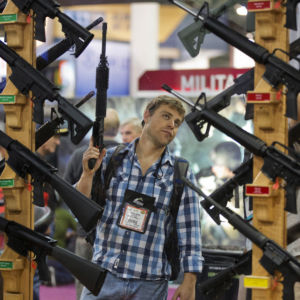I have until now eschewed writing about guns. It’s personal. I like guns.
I grew up in what might be called a gun culture, but it was very different from today’s gun culture in the United States. It was in colonial Africa and guns were for hunting. They were also, as here today, just for having, works of art to be revered.
Many boys, at age 13 or 14, got a .22 rifle. Some got a combination rifle and shotgun: a .22 rifle on the top and a .410 shotgun on the bottom.
Handguns didn’t figure: They were illegal. The only man I knew who had one was always worried that he’d be discovered and prosecuted. Automatic weapons were still on the horizon where we were in a British colony.
Military training, though sketchy, started early, when we were still in high school. We were issued British army, circa 1918, Lee Enfield .303 rifles — heavy, durable and lethal. We were told — as soldiers everywhere are — that our weapons were our best friends and would save our lives one day. We took the friendship part very seriously. People with guns do.
I still had some of that when I came to the United States in 1963. But my friendship with guns deteriorated in the era of the Saturday-night special.
Now in this era of the assault rifle, I believe our gun tolerance is a fatal social disease. It’s a public health issue right up there with the big killers and more terrible because so many of the victims, and most of the perpetrators, are children.
I was once the keynote speaker at a pro-gun group’s event. It was a seminal day, Nov. 5, 2008: the day after Barack Obama was elected president.
At that point, Obama had said nothing that I’d been able to find about guns. I told them that.
I told them about myself. I told them that members of my family, including my mother, had been professional hunters in the 1920s when felling large animals was acceptable, indeed regarded as a serious sport and as a way of harvesting nature’s bounty, even for ivory.
I didn’t tell them that I was leaning toward gun registration or my thoughts about the need to begin to turn the culture against guns, just as the culture had turned against homophobia and segregation. Just the facts. That’s what I tried to give them and what I had agreed with my speakers bureau. Yet when I sat down, the chairman said, “I think we have to read between the lines with journalists.”
The audience wasn’t what you might think of as gun extremists. They were serious, middle-class business people, mostly men; some were in the gun industry working for manufacturers. They believed that they were the victims of a vast left-wing conspiracy to destroy their businesses, their sport and their culture. They also believed, despite what I’d said, that I was the agent of that conspiracy.
So it is with my friends who are gun owners, from Florida to New Hampshire and across the country to Arizona. They vary from an erudite historian who has a collection of ancient and modern weapons in working order, to an electrician who believes he’s defending the people from the government by owning an AR-15, to a conservative economist who took to guns when he took to Republicanism.
Michael Gerson of The Washington Post has pointed out that the real child carnage, the senseless ghastly slaughter often over a gesture or an imagined slight, is in the inner cities. Tonight and tomorrow night, on and on, in the inner cities, children with guns will kill children, teenagers will kill teenagers. It’ll happen in Chicago and Baltimore and Detroit and across the country to Oakland, Calif. Those who’ve been betrayed by their upbringing, by their absent fathers, and by their schools will be betrayed again. This time by the false security of their friend: the gun.
We have an estimated 300 million guns in America and 265 million passenger vehicles. The difference is we know the whereabouts of the vehicles: We register them. We also engineer them for safety, and we teach the drivers to drive. With guns we do just the opposite.
Wake up America and smell the cordite. It’s going off and killing someone near you right now.

